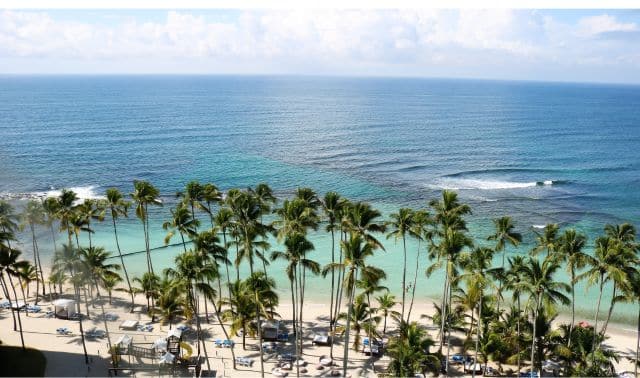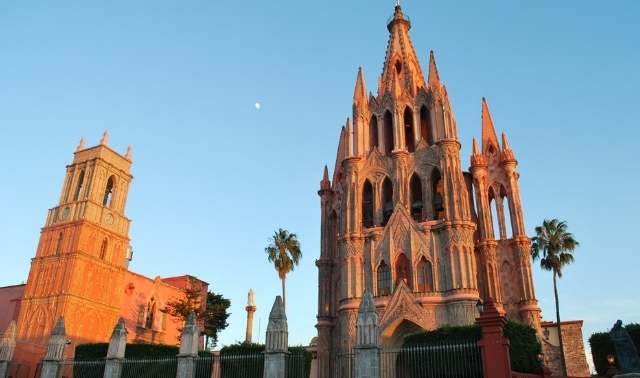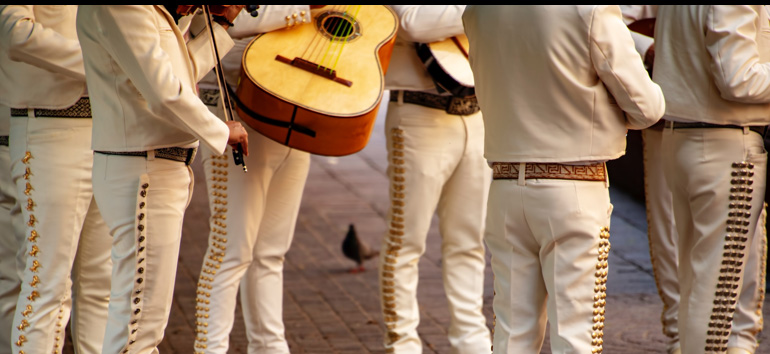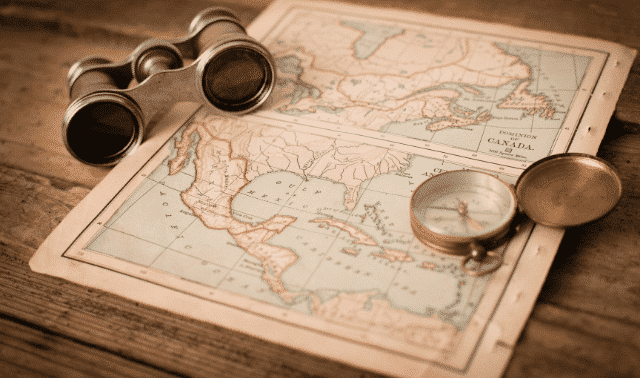When I first met my father-in-law, a Colombian-bom doctor living in the chilly Midwest, I sensed in him a feeling of longing. It was as if, although Rafael had spent the last 30 years of his life in Ohio, raised a family and enjoyed a career here, something intangible was missing. Was it the 12 brothers and sisters he left in Bogota? Probably, but more than that, Rafael misses the family history and culture he’s left behind.
Immigration brings an inherent desire and momentum for what’s ahead. Immigration also kindles an equally dyed-in-the-wool longing for what’s left behind. When people take risks to establish a life in a new country, they can experience great benefits. As the descendants of immigrants to the New World, all Central, North and South Americans share in those benefits — more land, more opportunity. But culturally, there’s always a sense of loss — what was it like? Where did our great-great-grandparents come from? Was Spanish life bad, or just boring? Did your parents suffer political upheaval in Peru, or were they simply adventurous?
The search for your roots is a way to regain that lost understanding. For Hispanics in the United States — who are not just part of the mainstream culture, but in many places, a dominant ethnicity — it’s a way to recapture how far you’ve come and where you came from.
Habla usted inglés?
To find out more about your Hispanic roots, start by looking to immediate family in the United States. Ask living family members for the names, birth dates and birthplaces of your ancestors. But also go beyond these basics and get your ancestors’ stories.
When setting up an interview, always ask your interviewee if you can tape the conversation. When you explain it’s for family history, your subject typically will be happy to oblige. Plan ahead to make sure you have a tripod for your video camera for personal interviews (it will make the videotaping less intrusive) and batteries for your recorder to tape phone interviews.
Before your interview, write out questions to be sure you don’t miss any crucial information. If you aren’t fluent in Spanish, ask the interviewee to spell out names for you. Simple mistakes such as spelling errors can lead you astray when you begin searching archived documents.
If yours is like most families, there may be a few relatives your interviewee would rather prune from the family tree. Save questions about black sheep for last, after you’ve had time to ingratiate yourself. Otherwise, Aunt Imelda might clam up and you’ll have a harder time with the rest of the interview.
When approaching family members for information about your ancestors, use any of three methods: person-to-person interviews, phone interviews or surveys. Person-to-person interviews work especially well with older family members who may not read or hear well. These interviews are the most time-intensive because you’ll likely go to your relative’s home, but the time is well-spent — these conversations provide the most vivid insight into your heritage. You may sit in silence with Aunt Imelda for 15 minutes while she tries to remember where cousin Aurelio lived. But while waiting, you notice the doilies decorating every speck of furniture in sight. You ask where the doilies come from, and suddenly Aunt Imelda is fluent with detail about the long, hot Puerto Rican afternoons when she and her sisters were cloistered in an upstairs room. Knitting, knitting, knitting until the hour when they could swing the wood-shuttered windows open wide and watch horse-drawn carriages of ladies and visitors parade past.
Telephone interviews and surveys can also provide valuable clues in your search for your Hispanic roots. When interviewing a relative by phone, be sure to record the conversation so you can review the tape for details. Surveys can be impersonal, and we all tire of being asked for information, so do your best to personalize the survey with a cover letter. Give survey recipients choices in how they respond to you — e-mail or postal mail, for example. Consider using the survey as a screening method for setting up interviews with extended family: Anyone who shows the remotest interest might be willing to do an interview, and you’ll be more likely to glean family stories on the phone or in person.
Answers to your genealogy prayers
Once you’ve tapped all of these home sources, you’ll find that Latin America’s strong Catholic heritage puts Hispanics in an especially privileged position when it comes to genealogical research. A bounty of vital records exists today because of a Catholic order made by the Council of Trent in the 16th century.
The Council of Trent directed the Catholic Church to keep records of population, in both the Old World and the New. With the very first ships to arrive off Latin America’s shores in the 1500s, churchmen stepped foot on dry land to establish the dominance of the Catholic Church in this hemisphere. Every time the church undertook a sacrament, officials were required by the Council of Trent to record the event in parish registers. This means you may be able to track births, marriages and deaths through Catholic records all the way back to the 1500s in some areas of Latin America, Spain and Portugal.
The search for parish records today is much easier than it was even 10 years ago, thanks in large part to the Internet and to the Family History Library (FHL) in Salt Lake City and its worldwide Family History Centers (FHCs) <www.familysearch.org>. The Internet provides you with online Hispanic genealogy message boards (see page 59), and the FHL and its branch FHCs provide microfilmed copies of parish records.
Finding la familia
Before you can tap the riches of parish records, however, you need to locate ancestral birthplaces. All parish records are identified geographically, and the birthplace is your starting point. FHCs maintain extensive map collections; a good atlas or the map collection at your local library will also be helpful. But you shouldn’t go straight to a map and start looking for the name of your ancestral hometown — many towns in Latin American countries share the same name. For example, Mexico has at least 10 towns named Santa Cruz. Make sure you get the right one!
Another complicating factor can be the changes in a country’s borders. Many Hispanic families have lived in what’s now the US Southwest since that territory belonged to Mexico, and before that, Spain.
Those shifting Southwestern borders might complicate your quest, but Michael Salinas, president of the Galvez Society for Hispanic Genealogy in New York, discovered that persistence can really pay off. “I first got into genealogy because I was helping my grandfather obtain a copy of his birth certificate,” says Salinas. “He didn’t have a copy and needed it for his pension. We didn’t have any paperwork for my grandfather’s side of the family and finally, we realized the reason why is because they’d been living [in the Southwest] for such an extended period of time.” Salinas gave up on the search for naturalization paperwork, and eventually found the birth certificate at a small parish outside of New Orleans. Salinas has now traced his family back to 1598 through Spanish land grants, all within the current borders of the United States.
To get the right place of origin, you can use geographic dictionaries called gazetteers. They’ll help you locate ancestral parish records as well. Gazetteers list localities and describe them in relation to their larger governing bodies. If you know your grandfather was born in Santo Domingo, but Santo Domingo has no parish records, a gazetteer will help you find the larger town nearby where those records may be kept. Gazetteers also provide information about local industry and population, which can further fill in the picture of your past.
What the records tell you
Once you’ve determined the birthplace of a relative and located it on a map, you’ll need to access that locality’s parish records. Many parish records are available through the FHL in Salt Lake City, which sends copies of its microfilms to local FHCs. You can quickly search the FHL’s catalog online by place: At <www.familysearch.org>, click on Family History Library Catalog, Place Search, and then fill in the place name plus (optionally) what country or state it’s in. Searching for Santa Cruz in the Mexican state of Oaxaca, for example, you’ll discover that parish records from 1704 to 1844 are available on microfilm; click View Film Notes for more details. (You’ll also see why it’s vital to get the exact place name right: There’s only one Santa Cruz in Oaxaca, but more than a dozen other places with Santa Cruz in their name, from Santa Cruz Acatepec to Santa Cruz Zenzontepec.)
You can also acquire parish records by writing to the ancestor’s parish and requesting genealogical information. You’ll need to send an international reply coupon (which you can buy at the post office), a money order for a nominal search fee and the full name, gender, birth date and birthplace of the person you’re seeking, along with when and where the event occurred. Any other details you can include, such as your relationship to the ancestor, the ancestor’s parents or other kin, will help the local parish find your relative. Explain why you’re interested in acquiring parish records, and ask for a photocopy of the complete original, not just a listing of the data. If you don’t feel comfortable communicating in Spanish, ask a relative or friend to write the parish request for you (don’t expect the parish to correspond in English). Or consult the FHL’s Spanish Letter-Writing Guide (see next page).
Among parish records, you’ll find records of baptisms, marriages and deaths. Baptisms (bauptismos in Spanish or batismos in Portuguese) typically list names, residences and birthplaces of the child, the child’s parents and grandparents. In marriage records (matrimonios or casamentos), you might come across other interesting information, such as exemptions of marriage restrictions for second cousins, or parental consent if the bride-to-be is underage. Death records (defunciones or obitos) may include a list of survivors and a notation if the individual left a will. Wills weren’t typical, though, so if you find evidence of a will it might mean the relative was wealthy or owned land.
You won’t always find wills within parish records, however. Throughout Latin America, wills were recorded by a notary and traditionally kept in the notary’s possession until he died. Wills were then handed off either to the notary’s successor or to a local, state or national archive. Should you be lucky enough to find an ancestor’s will, you’ll be privy to detailed financial information such as land deeds and boundaries, valuations and other information not divulged elsewhere.
While parish records are by far the oldest records kept in Latin America and Spain, you should also look to civil records for details about your ancestors. Civil records include births, marriages and deaths and were kept by local government officials starting around 1870 in most of Latin America. Some countries such as Brazil and the Dominican Republic began keeping civil records decades earlier. Many of these civil registers are now archived in regional or national libraries, as well as in FHCs and the FHL. Your Place Search of the FHL’s online catalog will also find these civil records.
Surnames on the double
As you dive into the records, Hispanic naming customs will make it easier to find your relatives, primarily because women keep their last names when they marry. In the Spanish tradition, a person takes on both the mother’s and father’s surnames, and uses the father’s last name as a family name. Here’s an example: Marta Gonzales Jimenez marries Juan Ignacio Perez. Marta keeps her name the way it is (some women add the husband’s last name to the very end: Marta Gonzales Jimenez de Perez). Then she has a child, Julia. Julia takes her father’s surname Perez as her own surname, Julia Perez. Then Julia adds her mother’s surname to the end: Julia Perez Gonzales. (Portuguese ancestors use the same double-surname system with a slight twist — the second surname is the family name.)
Surnames were consistently used this way even before the Spanish set foot in the Americas in 1492, and this makes your genealogical search a lot easier. You will almost always know the maiden names of your mother, grandmother and great-grandmother, and therefore you’ll know where to look next. This tradition can be a valuable clue when searching US records, including the census. American clerks or enumerators wouldn’t necessarily recognize this cultural difference in their record-keeping. So if you can’t find your Hispanic relative under the father’s surname, try looking for him under his mother’s.
Homeland historia
Another step to understanding and appreciating your family’s history is to learn more about the place where your relatives grew up. You’ll be able to do this through a variety of printed and archived material, including biographies, histories and genealogy journals.
Spanish colonialists began to arrive in the Americas in the early 1600s, and by the first half of the 1800s, approximately 12 million people had come to Latin America from Spain and Portugal. During the next century, immigration to Latin America reached 20 million, but not just from Spain and Portugal. People from England, Ireland, Germany, France and Italy filled the passenger ships bound for Latin America, especially Argentina, Brazil, Cuba and Uruguay. Today, when you research your Hispanic roots, you’ll likely find relatives from other European nations in addition to Spain.
To understand the immigration trends from Spain to your ancestor’s country in Latin America, you’ll turn to two different sources, depending on the time period. For immigration during the colonial period (1500 to 1800), the Archivo General de lndias (General Archives of Indians) in Seville, Spain, houses most records, some of which are archived in the FHL. From the mid-1800s on, ship passenger lists and arrival lists from major port cities, including Buenos Aires, Argentina; Salvador, Santos and Rio de Janeiro, Brazil; and Santiago, Chile, are housed in national archives in Latin America; some are available through the FHL. For a list of national archives’ addresses, see the previous page.
Another way to find background about your ancestral homeland is to read biographies. These personalized histories lend a lot of flavor and interest to your family’s story. The best place to look is in biography compilations covering specific geographic areas or groups of people. For example, the Archivo Biografico de Espana, Portugal e Iberoamerica (Biographical Archive of Spain, Portugal and Latin America), published by K.G. Saur, amasses 306 biographies and takes up 1,144 microfiche. You can access this type of comprehensive work through the FHL.
Be careful not to base all of your genealogical research on information gleaned from biographies, as you have no way of knowing how careful the author was in fact-checking. Always confirm the details you find in primary sources, such as parish or civil records. Otherwise, you may waste a significant amount of time before realizing you’ve gone astray.
Continuing the journey
You may decide after tracing your family history through interviews, research and historical study that you’d like to visit the land where your ancestors lived. This can be a rewarding and revealing experience, not in the sense of providing you with more data, but in a more personal, soulful way. The majority of facts you garner for your family tree will come from research done in libraries and archives. But all this dry information will come alive when you visit your ancestral town.
Edward Neyra is a Cuban-American who had just such an experience. Neyra left his homeland when he was 11 years old, and his memories faded fast as he eagerly embraced US culture. Four decades later, he returned to Cuba to find out more about his family history. The research he’d already done led him to his hometown of Cardenas, but he knew little about his family’s life there.
Neyra was struck by the sense of belonging he felt when meeting people who knew his family history. “I met a man named Kiko; he was like [Cardenas’] unofficial town historian. He had a memory like a library, and he said to me, ‘I know who you are,’” Neyra says. Kiko told Neyra all about his family, and provided him with a family tree that ultimately led him to 16th-century Spain.
For Neyra and other Hispanic genealogists, tracing the family tree back to the Old World isn’t the most rewarding aspect of researching Hispanic roots. Instead, uncovering family history fulfills that sense of longing all immigrants and descendants of immigrants feel about their past. “It’s the greatest gift that anyone can ever give,” Neyra says. “You get a little piece of your soul.”




